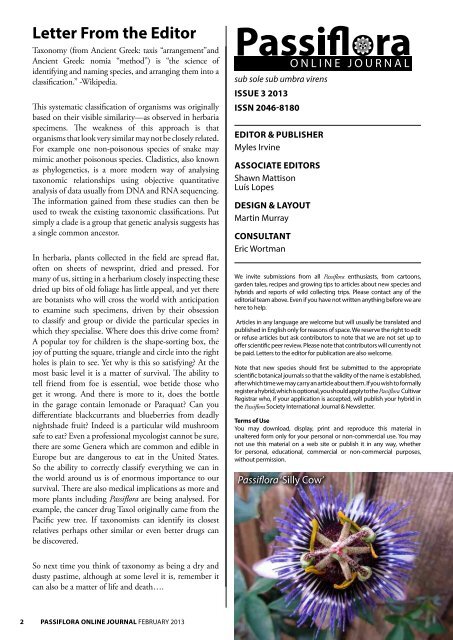Issue 3 2013 Lo-res PDF - Passion Flowers
Issue 3 2013 Lo-res PDF - Passion Flowers
Issue 3 2013 Lo-res PDF - Passion Flowers
You also want an ePaper? Increase the reach of your titles
YUMPU automatically turns print PDFs into web optimized ePapers that Google loves.
Letter From the Editor<br />
Taxonomy (from Ancient Greek: taxis “arrangement”and<br />
Ancient Greek: nomia “method”) is “the science of<br />
identifying and naming species, and arranging them into a<br />
classification.” -Wikipedia.<br />
This systematic classification of organisms was originally<br />
based on their visible similarity—as observed in herbaria<br />
specimens. The weakness of this approach is that<br />
organisms that look very similar may not be closely related.<br />
For example one non-poisonous species of snake may<br />
mimic another poisonous species. Cladistics, also known<br />
as phylogenetics, is a more modern way of analysing<br />
taxonomic relationships using objective quantitative<br />
analysis of data usually from DNA and RNA sequencing.<br />
The information gained from these studies can then be<br />
used to tweak the existing taxonomic classifications. Put<br />
simply a clade is a group that genetic analysis suggests has<br />
a single common ancestor.<br />
In herbaria, plants collected in the field are spread flat,<br />
often on sheets of newsprint, dried and p<strong>res</strong>sed. For<br />
many of us, sitting in a herbarium closely inspecting these<br />
dried up bits of old foliage has little appeal, and yet there<br />
are botanists who will cross the world with anticipation<br />
to examine such specimens, driven by their obsession<br />
to classify and group or divide the particular species in<br />
which they specialise. Where does this drive come from?<br />
A popular toy for children is the shape-sorting box, the<br />
joy of putting the square, triangle and circle into the right<br />
holes is plain to see. Yet why is this so satisfying? At the<br />
most basic level it is a matter of survival. The ability to<br />
tell friend from foe is essential, woe betide those who<br />
get it wrong. And there is more to it, does the bottle<br />
in the garage contain lemonade or Paraquat? Can you<br />
differentiate blackcurrants and blueberries from deadly<br />
nightshade fruit? Indeed is a particular wild mushroom<br />
safe to eat? Even a professional mycologist cannot be sure,<br />
there are some Genera which are common and edible in<br />
Europe but are dangerous to eat in the United States.<br />
So the ability to correctly classify everything we can in<br />
the world around us is of enormous importance to our<br />
survival. There are also medical implications as more and<br />
more plants including Passiflora are being analysed. For<br />
example, the cancer drug Taxol originally came from the<br />
Pacific yew tree. If taxonomists can identify its closest<br />
relatives perhaps other similar or even better drugs can<br />
be discovered.<br />
sub sole sub umbra virens<br />
<strong>Issue</strong> 3 <strong>2013</strong><br />
ISSN 2046-8180<br />
Editor & PUBLISHER<br />
Myles Irvine<br />
Associate Editors<br />
Shawn Mattison<br />
Luís <strong>Lo</strong>pes<br />
Design & Layout<br />
Martin Murray<br />
Consultant<br />
Eric Wortman<br />
We invite submissions from all Passiflora enthusiasts, from cartoons,<br />
garden tales, recipes and growing tips to articles about new species and<br />
hybrids and reports of wild collecting trips. Please contact any of the<br />
editorial team above. Even if you have not written anything before we are<br />
here to help.<br />
Articles in any language are welcome but will usually be translated and<br />
published in English only for reasons of space. We <strong>res</strong>erve the right to edit<br />
or refuse articles but ask contributors to note that we are not set up to<br />
offer scientific peer review. Please note that contributors will currently not<br />
be paid. Letters to the editor for publication are also welcome.<br />
Note that new species should first be submitted to the appropriate<br />
scientific botanical journals so that the validity of the name is established,<br />
after which time we may carry an article about them. If you wish to formally<br />
register a hybrid, which is optional, you should apply to the Passiflora Cultivar<br />
Registrar who, if your application is accepted, will publish your hybrid in<br />
the Passiflora Society International Journal & Newsletter.<br />
Terms of Use<br />
You may download, display, print and reproduce this material in<br />
unaltered form only for your personal or non-commercial use. You may<br />
not use this material on a web site or publish it in any way, whether<br />
for personal, educational, commercial or non-commercial purposes,<br />
without permission.<br />
Passiflora ‘Silly Cow’<br />
ONLINE JOURNAL<br />
Contents <strong>Issue</strong> 3<br />
04<br />
10<br />
12<br />
18<br />
Passiflora cristalina<br />
by John Vanderplank & Daniela Zappi<br />
A new species of Passiflora (Passifloraceae) from<br />
Mato Grosso, Brazil.<br />
Passiflora ‘Silly Cow’<br />
A new hybrid from Myles Irvine<br />
A new hardy polyploid hybrid from UK.<br />
Little Wonder<br />
The Discovery of Passiflora lutea ‘Sapelo’<br />
By Dan <strong>Lo</strong>ng<br />
A selection of Passiflora lutea discovered on Sapelo<br />
Island in McIntosh County, Georgia.<br />
Studies on Passiflora amabilis<br />
by Yero Kuethe<br />
Species, man-made or natural hybrid.<br />
22 Inside/Out<br />
by Dr Les King<br />
Highlighting the differences between the same<br />
Passiflora grown inside and out.<br />
28<br />
22<br />
In a bit of a Jam<br />
by Rosie Gan<br />
From vine to jamjar! The perfect and easy to make<br />
<strong>Passion</strong> fruit jam recipe!<br />
04<br />
12<br />
18<br />
So next time you think of taxonomy as being a dry and<br />
dusty pastime, although at some level it is, remember it<br />
can also be a matter of life and death….<br />
2 Passiflora Online Journal February <strong>2013</strong> Passiflora Online Journal February <strong>2013</strong> 3
















